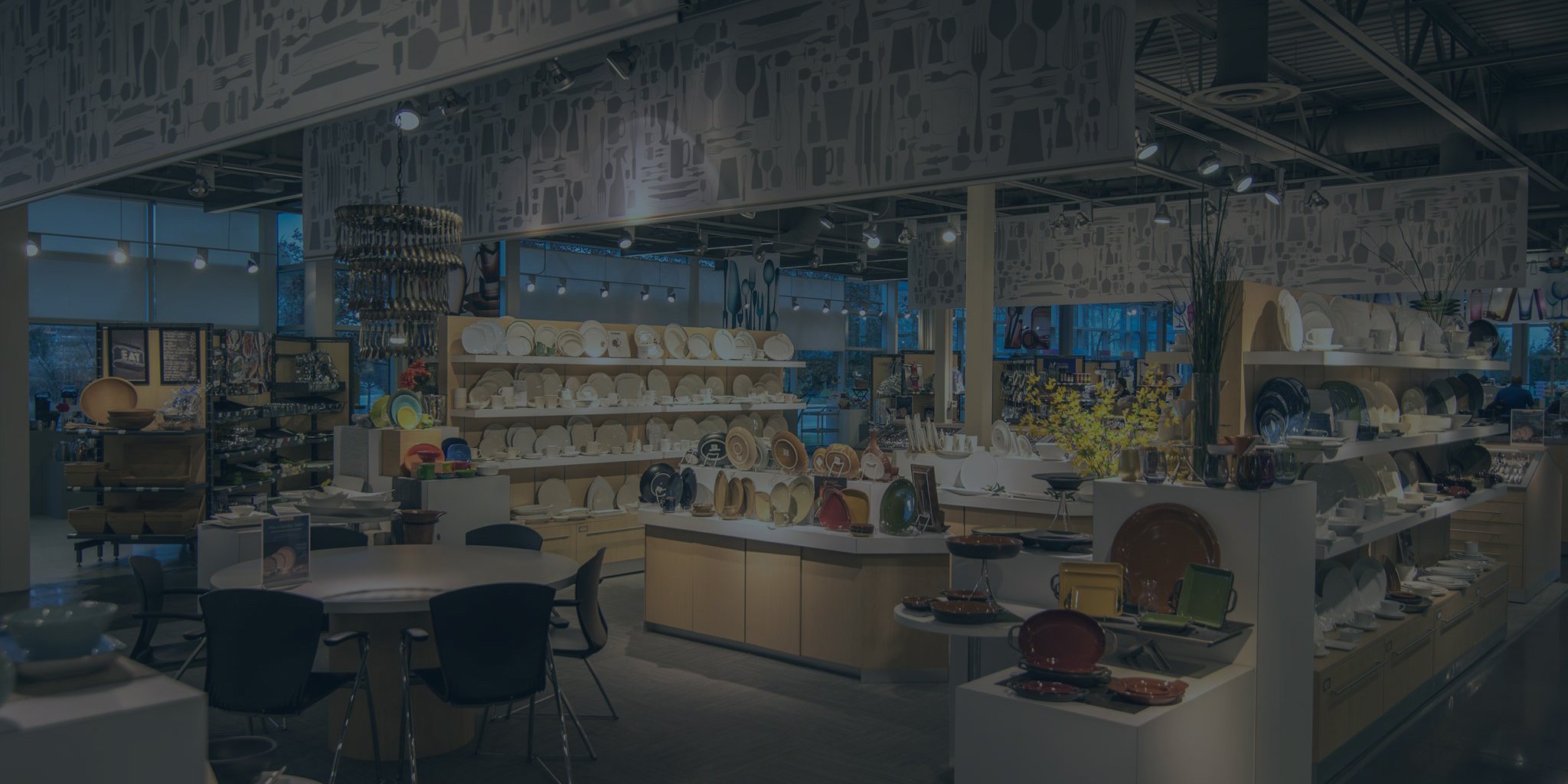In this episode of The Boelter Wire, Kevin Walsh, Director of Foodservice Healthcare Sales with Libbey, Inc., discusses the latest dining advancements in the world of senior living foodservice and explains how these innovations have been developed to specifically enhance the lives of the senior living community. Like many companies, Libbey has overcome a variety of business changes and adjustments from the last year while adjusting to COVID, which has also had a profound effect on senior living.
 If you love this episode, listen to our recent podcast about COVID-19 and how it impacts senior living communities across the country. Want to see more about Boelter's work? Check out our portfolio and some of our service offerings for senior living and healthcare.
If you love this episode, listen to our recent podcast about COVID-19 and how it impacts senior living communities across the country. Want to see more about Boelter's work? Check out our portfolio and some of our service offerings for senior living and healthcare.
Have a topic you'd like us to discuss? Send us your ideas at marketing@boelter.com!
Excerpts
William Braun: I'm excited to be joined today by Kevin Walsh. He is the Director of Foodservice Healthcare Sales with Libbey. Kevin, thank you for taking the time to talk with me today. How are you doing?
Kevin Walsh: I'm doing great. I appreciate you reaching out to me and being able to spend some time with you today, too.
I appreciate you taking some time today.
So, we're talking about Libbey. And as I was getting ready for this discussion, I took some time to look at the history and get up to speed as to where Libbey has been, where they're coming from. Pretty interesting history. They've been around for a long time. I was not aware that they've been around for as long as they actually have, which is really interesting.
I noticed that on the website, it said that they started out as a glass company, way back in the early 19th century and that they were the first company to automatically produce light bulbs. I’m not sure what that means exactly, "automatically," but that they go back that far.
It also said that they started around 1970. They started developing stemware and about 25 years later, they evolved to include more of an extensive line of tableware for the foodservice industry, which is obviously why you and I are here today having this conversation. And that they eventually evolved to have a really strong presence in the restaurant, the hospitality and the healthcare markets.
But, for today's discussion, what I really wanted to focus on with you Kevin, is Libbey's current offerings in the healthcare space and specifically, senior living. So, why don't you give us a little bit of a background as to your involvement with Libbey and how long you've been with the company, what your focus has been recently.
Kevin: Okay. Yeah, absolutely. I'm actually coming up on my second year with Libbey Glass – or Libbey, Inc., which includes some other brands that some people aren’t always are aware of, the World Tableware and the Syracuse China. And then we do partner with some German companies, Schonwald and Spiegelau. But, I've been two years coming, I think like October 1st. So, just a couple of weeks. It's been an interesting two years for sure. We've gone through quite a few different changes. You know, just recently the COVID has kind of changed some of our ways we go to market and some of our big end-users and our distributors, how they're going through the process of reopening and servicing the customers.
My background: I do have close to 20+ years in healthcare and senior living, and that's hospitals, skilled nursing. When I look at senior living or the way we've been talking about senior living with Libbey, in our team, trying to make sure it includes independent living (or IL), or assisted living (AL), and then memory care, which is the Alzheimer's and dementia care, maybe a little more specialty care. And then there is the skilled nursing healthcare and rehab side, but those services we look at as all part of senior living now. So maybe not the acute care like the hospitals, but we still do service that side.
But, senior living is where we're really putting a focus, initially with a lot of our solution sets and innovations. And you know why that's important? One, the aging population, they call it the "silver tsunami" is coming. I think it's 10,000 baby boomers are turning 65 a day.
...
After World War II, when people came home and started families, those boomers are now turning 65 at a rapid age. And I'm kind of down below that, I'm a generation X-er, where my son calls me a boomer. But I tell him, no, no, I'm not, I'm not a boomer, I'm a generation X-er. But he still calls me boomer on some of the things that happen around the house. "Okay. boomer," you know. You get that type of thing.
But, what we found in the senior living side is not only is it growing, but that they were developed around a health care setting. Like, that was kind of their focus, but now they're moving more towards health and wellness centers, like to keep people more active, keep people more independent, as long as they can.
How we fit in there with that side of IL, AL, memory care ... is the ability to still get to that communal dining, which ties to not only the food and hydration or the nutrition part, which is a huge part of senior living. You need to keep the right weight, the right nutrition, the right health, which goes along with aging more than ever. But, we look at the communal part is like the social nutrition, the ability to break bread with friends and family, and people that are inside a community and still have that social side.
Right now it's kind of harder than ever because of what COVID has had with the isolation part. But we want to battle that with our solutions. Battle isolation, battle loneliness, get them out ... and that's where senior living that kind of offer those amenities, whether it be dining or activities or fitness or crafts or games or worship, but get outside that individual and be more on the communal side.
I think that's going to be going forward. That's the way they want to focus is that health and wellness centers. And we want to be part of that and work with our distributor partners. Because they see that too. Right? They see that as, as important in this, in this growing segment.
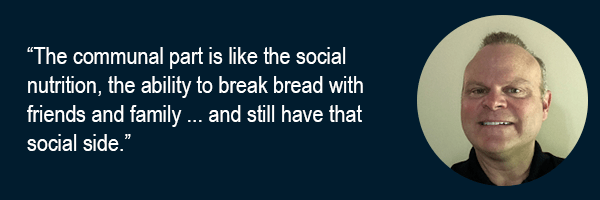 Well, and you bring up a lot of really good points there and you talking about the dining experience in general and how much that's a part of their lives. I think about the dining room and that dining room experience and how probably quite a few of the seniors that are living in the community find themselves probably spending more time in that dining room, you know, three times, sometimes even more than three times each day, than anywhere else. So, having that social aspect, that community, that gathering place, and then the complications that COVID kind of threw into it, it's really important from a health and mental wellbeing perspective.
Well, and you bring up a lot of really good points there and you talking about the dining experience in general and how much that's a part of their lives. I think about the dining room and that dining room experience and how probably quite a few of the seniors that are living in the community find themselves probably spending more time in that dining room, you know, three times, sometimes even more than three times each day, than anywhere else. So, having that social aspect, that community, that gathering place, and then the complications that COVID kind of threw into it, it's really important from a health and mental wellbeing perspective.
But one of the things that I'm thinking about is, as our loved ones continue to age, a lot of things that we take for granted, like enjoying a meal with friends and family and how that often, as people get older, becomes a possible source of frustration and difficulty for a lot of these seniors that are living in the community. What have you seen when it comes to that level of frustration and then the increased difficulty with just enjoying a meal, with those seniors?
Kevin: Yeah. I mean, and that's a good point. Because there's several things related to that dining experience in the senior community. As they struggle, we've seen some are just examples of communications when we're talking to the end user or to the communities that there's different areas.
We talked about independent living. Well, they may interact and still be with assisted living. So, if someone gets to need more, I guess, enhanced help, they get maybe even moved over to a different area in the dining room and they don't want to do that. Right? They want to stay with their friends. They want to stay independent. They want to be able to sit down with family members and not have a helper, say, feeding them, but they want to be able to be functional. They want to be able to know if they're not so coordinated, they want to be able to still basically dine as much as they can in a normal and dignified way. And that can relate to function, coordination, even the vision side.
And, on the culinary side, they know that, they're aware of those challenges. We as a company have found more out about those challenges. So, we're trying to help in that area and focus on innovation around that dignity. And then, with dignity, some of these solutions came, I think, with COVID too. It's also an increase on safety. And sometimes they go hand in hand, right? The more you can provide dignified solutions that sometimes they're safer solutions too, for those people in the dining room.
Yeah. When you're talking about innovations and dignity, I think that's got to be your specialty right now when you're looking at the senior living community. You wouldn't think there's going to be a lot of innovations when it comes to the dining experience, when it comes to the flatware, the plates, the dishes, the cups that are used on a regular basis. But when you really take a step back and think about it and think about how those innovations are targeting specifically the issues that seniors are experiencing during that dining experience, it's pretty interesting to think about.
Looking on Libbey's website and taking a peek at some of the things that you guys have been working on, it seems like the innovations that you guys have been focusing on kind of fall into different categories, and I'm hoping that we can kind of touch on a few of those categories. What would be some of those issues that Libbey has been looking at that you've been focusing on recently?
Kevin: Well, I think there's really three, four type of solutions are those areas that we are focusing on. And some of it is a curated collection. Like, we did look at our vast amount of solutions that we have, 5,000+ type of SKUs that maybe fit into these areas. But we have, like you mentioned, the last two years, really two and a half years, come out with new solution sets like that, that help with these areas. And whether it’s partnering with one of these branded partners that I talked about before. Um, but we've also come up with new solution sets on our own and, and the product teams have done that.
I would say functionality is, is a big piece. We're looking at grip, can scooping be made easier? Maybe there's deeper, harder edges that help with that scooping where instead of just going off the plate, you can actually get an edge and scoop up.
Weight, durability are very important because you don't want a heavy – a lot of times as a senior, you think about a 16 ounce or 12-ounce glass it's full of ice or water. That's a pound, over a pound. We don't want to have at the table because that's part of aging, that the heavier types of things we do want to remove or have a substitute.
And then unbreakable pieces like some of our drinkware, our beverageware we have got ventured into some high-end, high technology plastic instead of glass all the time. And then there's weld trays, puree trays for the mechanical process, types of food that help if they're having trouble swallowing. And then anything that we can kind of show that can help with that increase in calories and hydration, make it a little bit easier.
So, the functional part, you're touching on not just plateware, not just glassware, but pretty much anything that you're going to see or that they're going to be using during dinner. So, silverware, plateware, glassware, you guys are looking at all of that.
Kevin: Yeah, absolutely. The silverware, or flatware, we want things that can help with easier grip, better grip, easier to hold on to. Because ... there might be arthritis that's been going on or a smaller hand versus the female or the male hand different sizes. And so, weight and balance are very important and we've looked at different designs.
We've come out with basically two new lines altogether that are done very successful in that, the Clayton line and the Ada line. But, ergonomics, like I mentioned, the weight is more pleasant, helps with that arthritis and dexterity. The shape can help with the scooping.
One of the things, too, that someone had mentioned to me, I was like, "Well, why was this flatware, why was this dinnerware, why was this chosen versus some competitors'?" And they're like, "Well, they want something that's elegant, lightweight." They did like the bright white, and they sometimes want something with a better warranty, too ... Most of our higher-end things that we are pushing have at least a lifetime warranty or a five-year chip warranty on that.
Yeah, that makes sense. You know, and you're talking about arthritis. Obviously that's probably a big concern when people a little bit older. And you started to hint at the color of the plates, and I would think that that also speaks to potential vision issues that our seniors are experiencing.
What are some of the other things that you've been seeing that helped with that portion from a healthcare perspective? How does that work? How does that happen?
Kevin: As you know, as you age certain things decrease, like the dexterity, your strength, but vision is one of those also. So not only your peripheral vision, but sometimes that contrast that shows up kind of blends together. So, we're seeing more like solid colored plates that are used in memory care and Alzheimer's because they need that contrast. So your reds, your blues, your greens.
But then also we have a new line or added to the line, some white plates that match the body color of other plates, but they actually have bandings. So, they have a blue band around the outer edge or red band around the outer edge. We call that the banding. So there's color bands, there's solid colors, more help with that contrast.
So vision, you know, if you've got a white plate on a white tablecloth, white mashed potatoes, it's really hard for somebody to see that, but maybe you've got a white tablecloth, but then with a red plate. And then you've got your white food on there, whether it be green or whatever it is, it kind of pops better on a blue plate or – you know, there's no food that's blue. We used to say that on the food safety side. So, all that things on a blue or red plate pop, and then with the extra banding, it brings it to the center of the plate. So instead of kind of wandering or figuring out where the edge is, that helps ...
Not only the plate, but that's with your cups or your mugs. There's also double-handled mugs that that might be the same color, a white double-handle bug, or we've got double handle mugs that have that banding or have that coloring, too. So, they can see that on an edge or a saucer that has that vantage, they know where to put that saucer and it fits a little bit better when they're done. There's reds and blues on the double handles too.
But, you know, the whole thing is to reduce spilling, enhance the dignity where they don't need that extra assistant to help them dine. They're able to be more independent and be able to do that. Some of these lines we've got in porcelain, but then we did add some melamine where we've got solid color melamine .... That kind of helps in the safety side. if someone's in memory care where breakage might be an issue the melamine is a new line for us. I look it as a nice addition to the senior living piece of that. So yeah, I think that the depth perception and the alertness there really helps. And then the contrast, which all ties to the extra functionality and adaptability that that's there. So those are some important factors in and direct new products that we've launched around that.
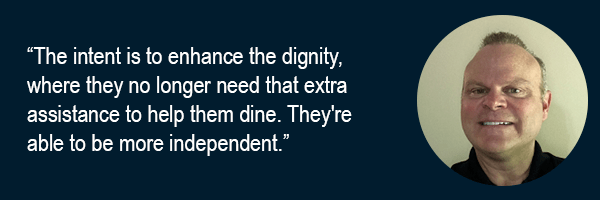 You kind of hit the nail on the head, too, when it comes to the dignity. Anytime they're able to do things more on their own than to have to have somebody there sitting next to them, helping them with the feeding, with eating their dinner ... I would imagine that they can do the majority of that still on their own with some of these new products that they can get through their meal, they can enjoy their meal, they can enjoy the meal with their loved ones and not have to focus exclusively just on getting food from the plate to their mouth. I think that's going to be a huge boost for the morale.
You kind of hit the nail on the head, too, when it comes to the dignity. Anytime they're able to do things more on their own than to have to have somebody there sitting next to them, helping them with the feeding, with eating their dinner ... I would imagine that they can do the majority of that still on their own with some of these new products that they can get through their meal, they can enjoy their meal, they can enjoy the meal with their loved ones and not have to focus exclusively just on getting food from the plate to their mouth. I think that's going to be a huge boost for the morale.
Kevin: We've heard stories on successes that we've had with some of our lines, whether it be the flatware, for the grip, or the vision ... What we heard was that sometimes someone would just have their food and they wouldn't even attempt at eating it because they were embarrassed by what was happening. Right? So they waited, they weren't getting their calories. They weren't getting their hydrates. They'd wait until their friends would be then done. So then maybe they go to an activity where then that person would try to do their best, but then they couldn't get to that activity as soon. So what we found in with some of where these tools were being utilized, that it brought more confidence back, more pride that they could do that. They finished their meal, they didn't delay eating, they ate right away. They had some of these pieces blend right in with normal flatware. So it's dignified.
I think being not embarrassed is a huge factor in that they weren't separated off. Some of these adaptive tools that are done from the past might be heavy duty plastic, or they've got even straps on them or a leather thing, and it's got Velcro. You hope they don't have to use that.
So they're eating better. They're eating in a quicker manner, getting their calories. And then I think you mentioned it, to be continued independence and then living their fullest life. And then I think that goes back to senior living. It's not necessarily the healthcare part, it's the health and wellness. They can get onto their social part of dining without being embarrassed and then even get onto the next, maybe after dinner activities.
Yeah. Eating dinner, lunch or breakfast is no longer a chore for them. It's no longer problematic.
You mentioned something, and you mentioned it just kind of in passing, but you were talking about straps or Velcro. What would those be used for? Or did I miss that?
Kevin: Those would be not anything that we have ... Our solutions are combating that, where if it would be an adaptive flatware piece or a special spoon ... they have to almost be Velcro-ed onto the hand where they rip it because of the arthritis or it's a larger, maybe a black plastic, round. That's not very appealing, not very dignified. Where we've come out with some flatware that kind of that's what we're selling against.
So, we mentioned that it's like, you know, when you're maybe at a table with four or five people, then you're the only one with something Velcro-ed or an odd looking. And that's where we want to make sure we're keeping them in a dignified situation where they feel comfortable and not singled out with a certain tool..
It almost sounds like they would be in the extreme situation or extreme case.
Kevin: No, you're right. I mean, you're absolutely right. That would be more almost on the rehab side. But some assisted living, you know, we've seen it. And then we've shown our Clayton, and it helps with that arthritis. And they're like, "Hey, we could use this." And we we'd rather get them the ability to try something, because some of these products that we've got and nobody's ever seen before, that's what's kind of cool is we show them at shows. And at some of the industry organizations and they were like, "Wow, I haven't even seen that," because it's not been in the industry for a while.
Well, and that really speaks to the level of innovation that you guys are working towards. And it segues into the next question I have for you ... What steps are Libbey taking when it comes to doing the research and the development? How are you guys arriving at some of these particular designs? Are you speaking with, or going out to, senior living communities? Are you talking with the directors there? Maybe even having conversations with actual residents? What does the research and development look like at Libbey?
Kevin: Libbey's, as you mentioned, been around for 200+ years, and we've built up a significant expertise in certain categories, with glassware, dinnerware, flatware, and our main, I guess, hotspot or wheelhouse has been hospitality, right? The hospitality side, the leisure side, the restaurants and the hotels. That's kind of our heritage, but we have extensively started reaching out to some experts that have helped us. We feel like with adding to the healthcare team, we've got three people that are dedicated healthcare, but we do lean on our hospitality team. The hospitality teams had 15, 20+ years in that side. And that is our heritage that we feel like we do need to get to the end user, do need to get to the residents and the directors of culinary.
So, find out what their pain points are, find out what they struggle with, and, you know, keeping that dignified and dignity piece. And so outside consultants, community leaders, anything that we can do with end user development. Our team wants to be similar to, you know, distributors with the distributor sales reps. They want to be in the community seeing what's going on here, what's going on, getting the feedback back, so we can take that back to our product managers and our marketing team.
You mentioned some of the industry, what we found out. I come in from acute care. I knew there were industry organizations around hospitals and skilled nursing. And then for senior living, there's Argentum, there's Leading Age, there's the senior housing news side, which has a dished show that they do that we're participating in. And then there's a new group out there called Senior Dining Association. And they're strictly focused on the culinary side.
So, we're not only doing the national shows, but we're sometimes doing the state chapter shows and getting involved and some of our stuff crosses over into actual physical therapy. So it's not only the dining side, it's like the therapist, like what we've done on the ergonomic side, too.
So, trying to talk to as many people and get the feedback. Some positive, some negative, but we want that, right? We've tried to show some things before that we thought might work and they're like, "Oh no, that's not going to be what you want to do because of this, on the plate." ... We love hearing that, because we know we can share that because I think that's one of our big things on the healthcare. And our team is sharing best practices, sharing what we hear with our partners, whether it’s distribution or end users, right? We want to share those.
One thing I'm interested in is when it comes to these senior communities, senior living communities, when you're going to have a new resident that maybe is having a walkthrough for the first time, one of the important things is what does the dining room look like? What does that dining experience look like? Because a lot of these residents, or future residents, that's still a very important part of their life. They want to have a really good experience when it comes to enjoying their meals.
So, everything that we've been talking about up to this point primarily has been more from a utilitarian, you know, these innovations, these designs, they're serving a purpose and they're really important in that purpose. But, on the, the other part of that equation is, you know, the overall presentation.
So, I imagine that even though they're utilitarian and they're helping our seniors with their meals, but how important is the presentation and when you're developing these new pieces of dining equipment, and I shouldn't say equipment, but new dining pieces?
Kevin: As you mentioned, when senior living communities are ... reaching out trying to get new customers or residents or clients. Usually, I mean, maybe not right now because of the position we're in with COVID, but I think it's 80% of a tour includes a meal, right? So, whether that be in the normal, I guess, senior dining room, maybe there's a bistro or a bar that they get to tour also, but sometimes it's in a VIP room set for that resident or the future resident.
So that is a huge part of recruitment and marketing is the dining experience, the culinary experience. Not only showing, not just your basic whites or your creams, but the higher end patterns, anything to elevate that experience and show the full range of what the offering is from that community. Because a lot of times it's not just a foodservice director. Sometimes it's a chef that's helping with that.
Or even the VIP side where they bring in, you know, it's not just the resident. A lot of times it's the family of the resident. A lot of times it's the grandparents that might be going, but then you've got the adult child that is with the father or then the kids come along, too, to see because they want to be able to eat there, too. So instead of coming in and getting dad and taking them to a sports bar, maybe they can do that in the community. Maybe they can have a nice Sunday dinner in the community. So, they're satisfying the senior resident, but they're also that adult child is one who pays the bills a lot of times, or is directing where the bills get paid.
They need to impress them. So, they see, you know, a lot of, "Hey, this is nicer stuff than we eat at home. This is what I'm going to be, you know, I'm proud to see and happy to see Mom or Dad eating on this type of flatware or dinnerware or the experience they get with it, whether it’s a Sunday brunch or a breakfast."
Just because they're living in that community doesn't mean they don't appreciate the things that they've grown up with recently. Like country club living or the cruise lines. A lot of time that's what the boomers have done. They travel more, they appreciate dining more.
So, whether it be freestyle or a speciwellfic sit down fine dining experience, that's what they want. They want that in senior dining. And we've seen that. And that's where I think that, you know, our hospitality background helps us open that door, but then we can help with these kind of specific pieces that we're adding to the line.
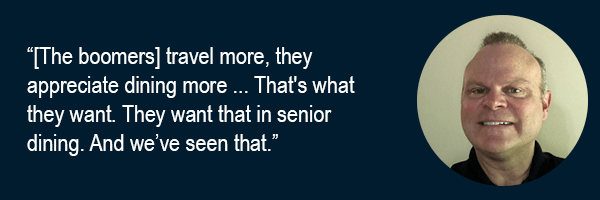 Well, and I was going to ask you, you already touched on it, but I was gonna ask you what the reception from the other family members has been to what Libbey has been producing, but you already hit on it.
Well, and I was going to ask you, you already touched on it, but I was gonna ask you what the reception from the other family members has been to what Libbey has been producing, but you already hit on it.
And the takeaway, I think, is that when you've got a family, not just the resident of a senior living community, so not just the grandparent, but you've got a family that is impressed with this dining experience, what is that going to equate to? It's going to equate to those family members spending more time, not only with their loved ones, but more time in that particular dining room. Instead of, like you said, instead of showing up to pick up grandpa and grandma and take them out somewhere, they're just going to show up, spend some time with them and then take them down to the dining room and spend more time with them directly there, so that's going to be even better business for that senior living community. And it's great to hear, it really is. It seems like we've come a long way in what senior communities once were and to where they are today. It's just great to hear.
Kevin: Yeah. And not only the dining room, you know, if they can offer ... a bistro or a wine bar that they can spend more time together at the community. And then, you know, the senior living community then can market that. And even, I would say, create profit centers around a nicer dining experience, whether with desserts or snacking and that type of thing.
It's all part of that, where they want to keep the resident there and they look forward to going having the meal at that location because the food is that great and the experience is that great.
Absolutely. Well, Kevin, that's pretty much all I had for you today. I appreciate you, again, coming on and talking to me about this. I think this was very helpful. Were there any last-minute things that you wanted to mention or talk about that we didn't get through?
Kevin: I don't think so. I think we covered everything. Like I said, I really appreciate you reaching out. Our world has kind of been turned upside down with the way we're able to connect with the industry, with our partners on both sides of distribution and the end user.
You know, a lot of things have gone virtual. Well, everything. And a lot of these shows that we talked about have gone virtual this year. Hopefully we can all get back together and meet face to face, and then even break bread together, be able to have a meal together. That's kind of what I'm looking forward for, too, but you know, right now we're doing what we can. I think it's been great with what you guys are doing and I appreciate you reaching out and spending some time with you.
Well, I appreciate it. Before we wrap things up, why don't you take a few minutes just to tell our listeners who are going to be listening to this podcast how they can reach out to you directly, what's the best way if they have more questions, if they wanted to talk to you about something specific. What are those methods of communication?
Kevin: We do have a Libbey website, so you can go to our website, and there's a lot of information there. There is actually a healthcare section of that, but then if someone wants to reach out directly to myself, Kevin Walsh, that would be kwalsh@libbey.com.
We do have some social channels out there, under the Libbey Pro, is where we've got that. And that, a lot of it is around the hospitality side ... we try to show inspiring photos or pictures there. We are looking at doing some specific things down the road for senior living and healthcare, but right now, reach out directly or there's the website.
I'm pretty sure we have, I know Instagram and there's a Twitter, and then there is a LinkedIn site also ... Our marketing team is kind of in the early stages of social media. We've had some of the things, but they're really trying to do more positive things they're in. I think that's the future too, right, is getting connected. And we are doing that.
...
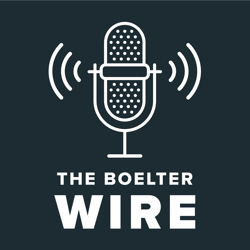
The Boelter Wire is an episodic podcast that focuses on thought-leadership conversations with industry experts and established partners, and is designed to help listeners evolve their business, stay competitive and pursue their passions.
Subscribe to The Boelter Wire here or on Spotify, Google Play, Apple Podcasts or Amazon Music.
.jpg?width=192&name=BLT_Only_Logo_Black%20(19).jpg)
